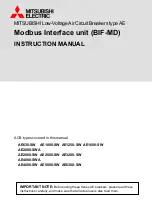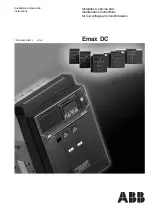
14
SECTION 9—Electrical Checks
Electrical checking consists of electrical breaker operation
primary and secondary wiring high-potential testing (if
required), primary circuit resistance (if required), PowerVac
®
interrupter high-potential testing, and insulation resistance to
ground.
9.1—Electrical Operation
To check the electrical operation, attach a secondary test
coupler to the circuit breaker connector. Check the control
voltage on the nameplate and close and open the breaker
several times.
CAUTION:
REPEATED OPERATIONS AT A RATE EXCEED-
ING TWO PER MINUTE MAY CAUSE CHARGING MOTOR
OVERHEATING AND FAILURE.
Leave the circuit breaker in an open and spring discharged
condition after checks are complete and refer to metalclad
instruction book GEK-39672 before inserting the circuit
breaker into a metalclad unit. Reinstall the front cover if it
has been removed.
9.2—High-Potential Test
If high potential tests to check the integrity of the primary
insulation is required, the AC high potential test described
below is strongly recommended. DC high potential testing is
not recommended. The following procedure must be adhered
to.
CAUTION:
IF DC HIGH POTENTIAL TESTING IS REQUIRED,
THE DC HIGH POTENTIAL MACHINE MUST NOT PRODUCE
PEAK VOLTAGES EXCEEDING 50 kV.
NOTE:
Always recheck with an AC tester if initial results are
questionable.
9.2.1 Primary Circuit
The breaker should be hipotted with the breaker closed.
An AC hipot machine capable of producing the test voltages
shown below may be used to hipot the breaker phase to
phase and phase to ground.
BREAKER VOLTAGE
AC TEST VOLTAGE
4.16 KV
14 KV
7.2 KV
27 KV
13.8 KV
27 KV
The machine should be connected with its output potential at
zero and the voltage increased at 500 volts per second to the
test voltage and that voltage maintained for 60 seconds. The
voltage should then be returned to zero and the test leads
removed from the circuit and the breaker discharged to ground.
NOTE:
Do not exceed the test voltage indicated for the
applicable breaker voltage rating. If the test should experience
a failure, STOP, turn off the test set and discharge the breaker
circuit.
1. Check the test set up and leads for connection errors.
2. Wipe down the breaker to remove any moisture, dust and
contamination.
3. Retest the breaker at the proper test voltage.
9.2.2 Secondary Circuit
Prior to hipotting the breaker secondary circuit, disconnect
the motor leads and thread a wire connecting all secondary
disconnect pins, except #24, the ground pin. Connect the
hipot machine from this wire to ground. Increase the voltage
to 1125 volts (rms) 60 Hz and maintain for 60 seconds.
Reduce the voltage to zero and remove the hipot machine
from the circuit. Remove the wire connecting the secondary
disconnect pins and reconnect the motor leads.
9.3—Primary Circuit Resistance
A resistance check of the primary circuit may be made
with the breaker closed. Use a low resistance measuring
instrument rated 100 amperes which measures in microhms.
The 100 ampere reading should be 30 to 60 microhms for a
1200 amp. Breaker, 25 to 50 for a 2000 ampere breaker. and
5 to 25 microhms for a 3000 ampere breaker when connected
across the primary bars on the breaker side of the disconnect
fingers. Do not connect directly to the disconnect fingers as
errors may occur due to finger spring pressure.
9.4—Vacuum Interrupter Integrity Test
NOTE:
Use of a DC hipot is not recommended, but can be
used for quick field checks only.
DC testers frequently yield
false negative test results due to the capacitive component of
the vacuum interrupter during DC testing. In addition, most
lightweight DC testers have a very low leakage current trip
setting. Always recheck with an AC tester if initial results are
questionable. Prior to performing any vacuum interrupter
integrity test, the outside (external surface) of the vacuum
interrupters should be wiped clean of any contaminates with a
non-linting cloth or industrial type wiper. This is critical: the
entire external surface is to be completely free of all dirt,
debris, dust, oil, etc.
CAUTION:
X-RADIATION WILL BE PRODUCED IF AN
ABNORMALLY HIGH VOLTAGE IS APPLIED ACROSS A PAIR
OF ELECTRODES IN A VACUUM. X-RADIATION WILL
INCREASE AS VOLTAGE INCREASES AND/OR AS CONTACT
SEPARATION DECREASES. ONLY TEST A CORRECTLY-
ADJUSTED CIRCUIT BREAKER.
DURING A HIGH POTENTIAL OR A VACUUM INTEGRITY
TEST, ANY X-RADIATION WHICH MAY BE PRODUCED WILL
NOT BE HAZARDOUS AT A DISTANCE SAFE FOR HIGH
POTENTIAL TESTING, IF THE TEST IS CONDUCTED AT THE
RECOMMENDED VOLTAGE AND WITH THE NORMAL OPEN
CIRCUIT BREAKER GAP.
DO NOT APPLY VOLTAGE THAT IS HIGHER THAN THE
RECOMMENDED VALUE. DO NOT USE CONTACT SEPA-
RATION THAT IS LESS THAN THE RECOMMENDED OPEN-
POSITION BREAKER CONTACT GAP.
A vacuum integrity test of the interrupter is required to ensure
that no loss of vacuum has occurred. The vacuum integrity
test is performed using an AC hi-potential tester. This test of
the vacuum interrupter will determine its internal dielectric
condition and vacuum integrity. With the breaker open,
Summary of Contents for PowerVac GEK-86132G
Page 26: ...26 C Breaker closed spring discharged D Breaker closed spring charged Figure 16 Continued ...
Page 28: ...28 Figure 17 Continued ...
Page 29: ...29 Figure 18 Typical wiring diagram for ML 18 and ML 18H mechanisms ...
Page 38: ...Intentionally Left Blank ...
Page 41: ...Notes ...
Page 42: ...Notes ...
Page 43: ...Intentionally Left Blank ...














































